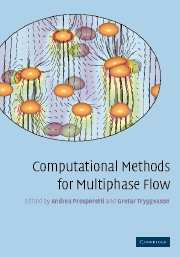Book contents
- Frontmatter
- Contents
- Preface
- Acknowledgments
- 1 Introduction: A computational approach to multiphase flow
- 2 Direct numerical simulations of finite Reynolds number flows
- 3 Immersed boundary methods for fluid interfaces
- 4 Structured grid methods for solid particles
- 5 Finite element methods for particulate flows
- 6 Lattice Boltzmann models for multiphase flows
- 7 Boundary integral methods for Stokes flows
- 8 Averaged equations for multiphase flow
- 9 Point-particle methods for disperse flows
- 10 Segregated methods for two-fluid models
- 11 Coupled methods for multifluid models
- References
- Index
10 - Segregated methods for two-fluid models
Published online by Cambridge University Press: 07 December 2009
- Frontmatter
- Contents
- Preface
- Acknowledgments
- 1 Introduction: A computational approach to multiphase flow
- 2 Direct numerical simulations of finite Reynolds number flows
- 3 Immersed boundary methods for fluid interfaces
- 4 Structured grid methods for solid particles
- 5 Finite element methods for particulate flows
- 6 Lattice Boltzmann models for multiphase flows
- 7 Boundary integral methods for Stokes flows
- 8 Averaged equations for multiphase flow
- 9 Point-particle methods for disperse flows
- 10 Segregated methods for two-fluid models
- 11 Coupled methods for multifluid models
- References
- Index
Summary
The previous chapter, with its direct simulation of the fluid flow and a modeling approach to the particle phase, may be seen as a transition between the methods for a fully resolved simulation described in the first part of this book and those for a coarse-grained description based on the averaging approach described in Chapter 8. We now turn to the latter, which in practice are the only methods able to deal with the complex flows encountered in most situations of practical interest such as fluidized beds, pipelines, energy generation, sediment transport, and others. This chapter and the next one are devoted to numerical methods for so-called two-fluid models in which the phases are treated as interpenetrating continua describing, e.g. a liquid and a gas, or a fluid and a suspended solid phase. These models can be extended to deal with more than two continua and, then, the denomination multifluid models might be more appropriate. For example, the commercial code OLGA (Bendiksen et al., 1991), widely used in the oil industry, recognizes three phases, all treated as interpenetrating continua: a continuous liquid, a gas, and a disperse liquid phase present as drops suspended in the gas phase. The more recent PeTra (Petroleum Transport, Larsen et al., 1997) also describes three phases: gas, oil, and water. Recent approaches to the description of complex boiling flows recognize four interpenetrating phases: a liquid phase present both as a continuum and as a dispersion of droplets, and a gas/vapor phase also present as a continuum and a dispersion of bubbles.
- Type
- Chapter
- Information
- Computational Methods for Multiphase Flow , pp. 320 - 385Publisher: Cambridge University PressPrint publication year: 2007
- 2
- Cited by



